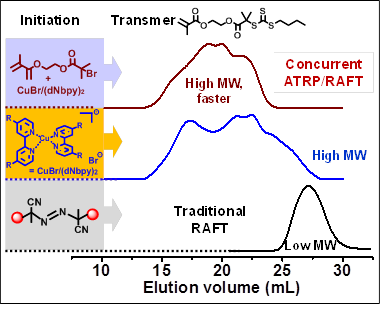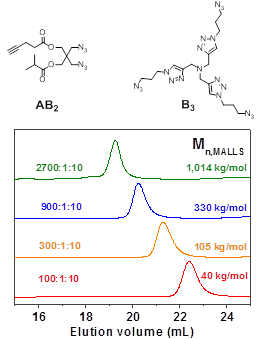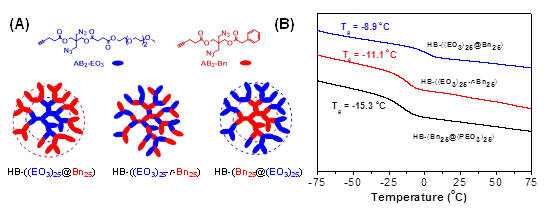Reports: DNI754298-DNI7: Mechanistic Study on Synthesis of Hyperbranched Polymer with Uniform Structure
Haifeng Gao, University of Notre Dame
The goal in this ACS PRF grant is to develop one-pot synthetic methods that allow to produce hyperbranched polymers with high molecular weights, high degree of branching and low polydispersity. In the past year (08/01/2015-07/31/2016), we have accomplished in three aspects.
1. Produce hyperbranched polymers with high molecular weight in RAFT homopolymerization.
As compared to the popular use of ATRP and NMP techniques, the traditional RAFT homopolymerization of polymerizable chain transfer agent, e.g., transmer, has never been able to produce high-molecular-weight hyperbranched polymers mainly because RAFT uses thermal initiator as radical source. Very recently, our group explored this subject and proposed a new strategy to achieve the first synthesis of hyperbranched polymers with very high molecular weights in the homopolymerization of transmer (Figure 1). This new method used copper catalyst to activate the alkyl trithiocarbonate to generate radicals without the use of thermal initiator and eliminating the presence of primary radicals. When small amount of ATRP inimer was added, the concurrent ATRP/RAFT homopolymerization of transmer achieved faster polymerization rate and produced hyperbranched polymers with both high molecular weight and high degree of branching. This progress has been published in Macromolecules 2016, 49, 6471–6479. The results generated in this project open opportunity in several new projects: 1) concurrent ATRP/RAFT polymerization of transmers in microemulsion to regulate the bimolecular reaction and the molecular weight distribution, 2) photocatalyzed polymerization of transmers and inimers in solution or microemulsion, 3) decoration of hyperbranched polymers from transmer via selective coupling reactions between primary radicals and propagating radicals.
Figure 1. The first synthesis of high-molecular-weight hyperbranched polymers via concurrent ATRP/RAFT homopolymerization of transmers.
2. Develop the chain-growth CuAAC polymerization of AB2 monomers
Since the first development of this novel chain-growth CuAAC click polymerization of AB2 monomers in 2015, we now expand the method to include a series of monomer families with various ABm (m = 2, 3) structures and dangling R functional groups. Recent development in my group has achieved the controllability of molecular weight (Mn = 103 - 106) with low polydispersity (Mw/Mn< 1.05) in a one-pot reaction completed within hours (Figure 2). The "living" polymerization nature allowed facile sequential addition of different AB2 monomers into the one-pot polymerization, producing dendritic polymers with layered structures being accurately controlled at nanometer scale. These polymers exhibited not only excellent site isolation effect to protect the core domain, but also broad tunability of solubility, thermal properties and stimuli-responsive degradability (Figure 3). Progress in this project has generated three peer-reviewed research articles, Macromolecules 2016, 49, 5342–5349, Macromolecules 2016, 49, 4416-4422, Macromolecules 2016, 49, 760-766, and one feature article in Nanoscale 2016, 8, 4864-4881. Considering the broad application of CuAAC reaction in polymer synthesis, the easy functionalization of ABm monomers, and the potential coordination of triazole with metal cations, this one-pot CuAAC polymerization is expected to generate broad interest in both polymer chemistry and materials science.
Figure 2. Overlaid size exclusion chromatography (SEC) curves of hyperbranched polymers synthesized using various ratio of [AB2]0/[B3]0.
Figure 3. (A) Core-shell structured hyperbranched polymers with same chemical compositions but different monomer sequence distribution, B) Stacked differential scanning calorimetry curves of the three hyperbranched polymers, HB-((EO3)25@Bn25), HB-((EO3)25-r-Bn25), HB-(Bn25@(EO3)25).
3. Educational and outreach impact
The research progress has generated two aspects of education and outreach impacts. First, the proposed experiments and research achievements allows the participating graduate student, postdoc and undergraduate student (registering for research credit with no stipend) to learn the state-of-the-art polymer chemistry knowledge, experimental skills and get hands-on experience on various polymer characterization techniques. The research results have also been integrated in the PI’s polymer chemistry course to senior undergraduate students and graduate students from both Department of Chemistry and various Engineering departments. Second, the PI has organized two annual Notre Dame soft materials symposia in 2014, 2015 and the 3rd ND-Purdue joint soft materials symposium will be held on October 8, 2016 at Notre Dame with expected more than 50 participants from both schools and a visitor from University of Illinois Chicago. In addition, the PI has successfully organized an ACS symposium “Advances in Functional Polymers with Sophisticated Branched Structures” together with two other faculty Dr. Chong Cheng (University of Buffalo) and Dr. Renaud Nicolay (ESPCI-Paris, France) at the 252nd ACS National Meeting in Philadelphia, Aug 21-25, 2016.














